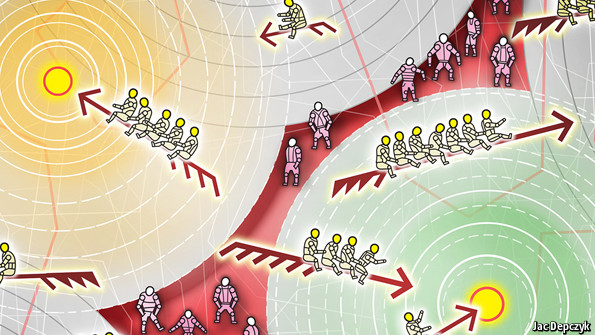
With it being Trump’s inauguration today, I thought I’d highlight an article from November by Nate Silver. Where did Clinton do well and where did she falter?:
I took a list of all 981 U.S. counties with 50,000 or more people and sorted it by the share of the population that had completed at least a four-year college degree. Hillary Clinton improved on President Obama’s 2012 performance in 48 of the country’s 50 most-well-educated counties. And on average, she improved on Obama’s margin of victory in these countries by almost 9 percentage points, even though Obama had done pretty well in them to begin with.
Yet, when he looks at “50 counties (minimum population of 50,000) where the smallest share of the population has bachelor’s degrees,” the tune changes considerably:
These results are every bit as striking: Clinton lost ground relative to Obama in 47 of the 50 counties — she did an average of 11 percentage points worse, in fact. These are really the places that won Donald Trump the presidency, especially given that a fair number of them are in swing states such as Ohio and North Carolina. He improved on Mitt Romney’s margin by more than 30 points (!) in Ashtabula County, Ohio, for example, an industrial county along Lake Erie that hadn’t voted Republican since 1984.
Silver continues by showing just how important education was in determining Trump/Clinton support:
- High-education, medium-income white counties shifted to Clinton.
- High-income, medium-education white counties shifted to Trump.
- Highly educated majority-minority counties shifted toward Clinton.
- Low-education majority-minority counties shifted toward Trump.
Silver concludes,
In short, it appears as though educational levels are the critical factor in predicting shifts in the vote between 2012 and 2016. You can come to that conclusion with a relatively simple analysis, like the one I’ve conducted above, or by using fancier methods. In a regression analysis at the county level, for instance, lower-income counties were no more likely to shift to Trump once you control for education levels. And although there’s more work to be done, these conclusions also appear to hold if you examine the data at a more granular level, like by precinct or among individual voters in panel surveys.
So it wasn’t necessarily the economically destitute that voted for Trump. A 2016 Gallup study found
that Americans who live in places where employment in manufacturing has declined since 1990 are not more favorable to Trump. Rothwell [the author] did not find a relationship when he focused only on white respondents, either, or even specifically on white Republicans. Trump’s supporters have many other traits in common with the factory workers whose economic prospects have been negatively affected by automation and global trade. They tend to be less educated men who hold blue-collar occupations. Yet those two broad trends in factory work do not account for Trump’s appeal, Rothwell’s analysis suggests. In fact, among those who share other traits, those who live in districts with more manufacturing are less favorably disposed toward Trump.
However, Silver offers a few “competing hypotheses” to the straightforward interpretation above:
- Education levels may be a proxy for cultural hegemony. Academia, the news media and the arts and entertainment sectors are increasingly dominated by people with a liberal, multicultural worldview, and jobs in these sectors also almost always require college degrees. Trump’s campaign may have represented a backlash against these cultural elites.[ref]I’m partial to this explanation.[/ref]
- Educational attainment may be a better indicator of long-term economic well-being than household incomes. Unionized jobs in the auto industry often pay reasonably well even if they don’t require college degrees, for instance, but they’re also potentially at risk of being shipped overseas or automated.
- Education levels probably have some relationship with racial resentment, although the causality isn’t clear. The act of having attended college itself may be important, insofar as colleges and universities are often more diverse places than students’ hometowns. There’s more research to be done on how exposure to racial minorities affected white voters. For instance, did white voters who live in counties with large Hispanic populations shift toward Clinton or toward Trump?
- Education levels have strong relationships with media-consumption habits, which may have been instrumental in deciding people’s votes, especially given the overall decline in trust in the news media.
- Trump’s approach to the campaign — relying on emotional appeals while glossing over policy details — may have resonated more among people with lower education levels as compared with Clinton’s wonkier and more cerebral approach.
So with that, enjoy Inauguration Day.
 Estimates document that the bombing of South Vietnamese population centres backfired, leading more Vietnamese to participate in Viet Cong (VC) military and political activities and increasing VC attacks on troops and civilians. The initial deterioration in security entered the next quarter’s security score, increasing the probability of future bombing and hence leading to sustained increases in VC activity. Moreover, while US intervention aimed to build a strong state and engaged civic society that would provide a bulwark against communism after US withdrawal, bombing instead reduced the probability that the local government collected taxes, decreased access to primary schools, and reduced participation in civic organisations. To the extent that spillover effects of bombing on other locations exist, the impacts tend to go in the same direction as the effects on the locations that were bombed.
Estimates document that the bombing of South Vietnamese population centres backfired, leading more Vietnamese to participate in Viet Cong (VC) military and political activities and increasing VC attacks on troops and civilians. The initial deterioration in security entered the next quarter’s security score, increasing the probability of future bombing and hence leading to sustained increases in VC activity. Moreover, while US intervention aimed to build a strong state and engaged civic society that would provide a bulwark against communism after US withdrawal, bombing instead reduced the probability that the local government collected taxes, decreased access to primary schools, and reduced participation in civic organisations. To the extent that spillover effects of bombing on other locations exist, the impacts tend to go in the same direction as the effects on the locations that were bombed.



 In a world with just two countries, one developed and the other poor, output is produced in each by a combination of skilled workers and unskilled workers. When they’re young, unskilled workers have the opportunity to become skilled by working with older, skilled workers.
In a world with just two countries, one developed and the other poor, output is produced in each by a combination of skilled workers and unskilled workers. When they’re young, unskilled workers have the opportunity to become skilled by working with older, skilled workers.
 So write three scholars drawing on their
So write three scholars drawing on their 